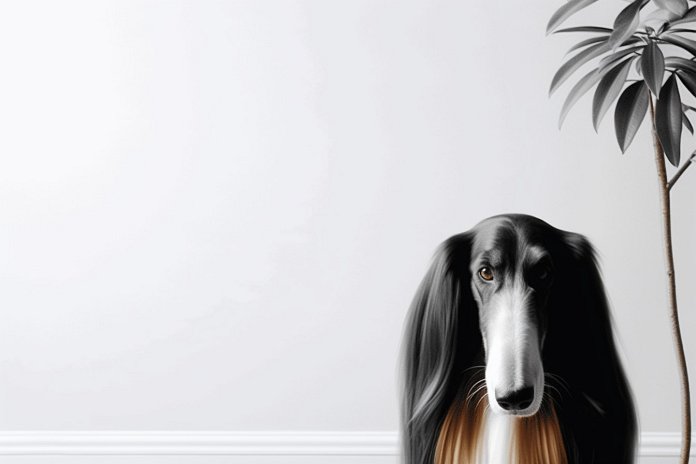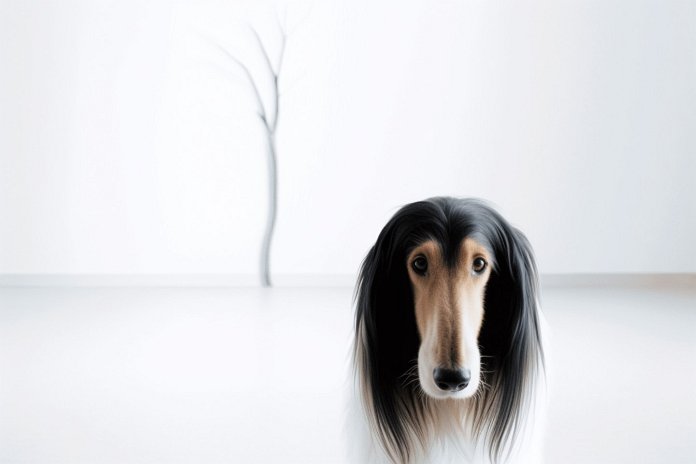
The Afghan Collie is a cross between an Afghan Hound and a Border Collie. It has a medium-sized physique and a long, thick coat. This hybrid breed has a range of skills, including sighting, tracking, retrieving, detecting drugs, obedience, and agility. They are known to be sociable and active, making them great companions. With their hunting and gathering abilities, they are also well-suited for security purposes. The Afghan Hound and the Border Collie, both originating before the 1800s and arriving in America in the 1900s, contribute their unique traits to this breed. The Afghan Collie falls in the mid- to big-sized range, with the Afghan Hound being a huge breed and the Border Collie falling into the medium-sized category.
Ahead, we look at Afghan Collie dog breed, its history, personality, pros and cons of owning an Afghan Collie, characteristics, and must-know facts. We will also examine how to care for this breed and a lot more. Prepare for a tail-wagging adventure into the world of Afghan Collies!
| Dog Breed | Afghan Collie |
| Size | Large |
| Weight | 35-55 lbs (average) |
| Height | 19-25″ (average) |
| Location | United States |
| Ancestry | Afghan Hound, Border Collie |
| Date of Origin | 2000 |
| Group | Hunting, Herding |
| Life Expectancy | 11-15 years |
| Price | $600 – $800 |
| Family | Canidae |
| Scientific Name | Canis Lupus Familiaris |
📖 Breed History
The Afghan Collie is a relatively new breed, so not much is known about its specific history. However, by examining the history of its parent breeds, we can gain some insight into what to expect from the Afghan Collie. The Afghan Hound originated in the mountains of Afghanistan and was used by hunters to track and capture game. It gained popularity over time, but remained mostly in the hands of wealthy families and royalty. The breed was introduced to America in the 1920s and was recognized by the American Kennel Club (AKC) in 1926. While it enjoyed a period of popularity in the show ring, it has since declined in popularity.
The Border Collie, on the other hand, has a longer history. It is believed that depictions of the breed can be found in wood carvings dating back to before the 1800s. The breed gained recognition when a Border Collie named Hemp won the first sheepdog trial in the late 1800s. Hemp was known for his ability to herd sheep by simply using his gaze, rather than barking or nipping at them. Queen Victoria also took a liking to the breed when she encountered one at Balmoral. The standard for the Border Collie was established in 1906, with a focus on their working abilities rather than their physical appearance. Originally referred to as sheepdogs, they were officially named Border Collies in 1915, derived from the region where they were first recognized, between the English and Scottish borders. However, it wasn’t until 1995 that the AKC recognized the breed.
Overall, while the history of the Afghan Collie itself is relatively unknown, understanding the backgrounds of its parent breeds can give us some insight into what kind of traits and characteristics it may have inherited.

🐕 Afghan Collie Appearance
A medium to large dog, the Afghan Collie has a long body and long, lustrous hair. They have a wooly undercoat that is white, brown, gray, blue, reddish-brown, or black, and their coat is thick and lengthy. They feature enormous, padded paws, long, curled tails, long, hairy, floppy ears, a large snout, and a long, black nose. The Border Collie is a medium-sized dog with a broad back and muscular legs developed for working, whereas the Afghan Hound is a huge, attractive, yet powerful breed. Both breeds feature oval eyes that are typically brown if the dog is any other color or blue if the dog is merle, and they both have intelligent faces. They have blocky skulls, powerful jaws, and a scissor bite. The lineage of the breed ensures that it will be both strong and elegant.
| 👀 Eye Color | Brown |
| 🐽 Nose Color | Black |
| 🐕 Coat Color | Sable, White, Red, Brown, Black |
⚡ Fun Fact: Afghan Collie dogs are a social breed. They enjoy being around people or other animals. This breed doesn’t tolerate being left alone.
🐶 Traits & Temperament of Afghan Collie
Both Border Collies and Afghan Hounds are very clever dogs who adapt readily to any kind of training. The Border Collie will go out of its way to satisfy its owner, unlike the Afghan who might be a little bit difficult. Due to their history as sheepherders, they are devoted and trustworthy and have historically been wonderful family pets and watchdogs. Due to their heritage of sheep guarding, both breeds make excellent security dogs. They get along well with kids, but they need to be watched because they have a tendency to herd the smaller kids. Early animal socialization is crucial if you want your children to get along with other pets.
🤝 Are Afghan Collies Friendly or Aggressive?
Afghan Collie dogs tend to get along well with other pets and are generally friendly towards strangers. They are also very good with children and enjoy being in their company. While they are only moderately friendly towards cats and other dogs, Afghan Collies are considered one of the top breeds for elderly individuals.
This breed is known for being:
- Aloof
- Dignified
- Independent
- Clownish
- Happy
- Energetic
- Protective
- Alert
- Intelligent
- Responsive
- Loyal
- Tenacious
🐩 Afghan Collie Care & Maintenance
The Afghan Collie is probably a moderate shedder because the Afghan Hound sheds at a low level and the Border Collie at a moderate to high level. Every other day, use a metal comb and a stiff-bristled brush to brush your Afghan Collie. You should use your fingers to disentangle the mats so you don’t harm the Afghan Collie’s sensitive hair and may wash him when necessary. The finest shampoo and conditioner to use are those that your doctor suggests. If you reside in a warmer area, professional trimming is advised because to their thick and wooly undercoat. Additionally, it is advised that you wash your dog’s teeth frequently, trim their nails frequently, and check their ears periodically for wax and dirt.
The Afghan Collie dogs have a moderate amount of shedding, which is a normal part of their hair growth cycle. Regular brushing helps to minimize the amount of hair that is shed. The extent of shedding can vary depending on the dog’s health and breed. In terms of bathing, it is recommended to give Afghan Collie dogs a bath every 6-8 weeks.
🍖 Food: We recommend 2.5 cups daily, costing you about $1.20 – $1.40 daily, or approximately $34.00 – $45.00 a month.
🐾 Exercise: Afghan Collie dogs need a lot of exercises. Long walks should be on a daily schedule. If you live an active life, this breed can be a good choice for you.
This dog breed requires to be walked for roughly 14 miles per week, which equates to about 60 minutes of physical activity daily. This consistent moderate exercise regimen will help maintain their physical wellness and significantly contribute to their mental stimulation. Consciously setting aside this time for your furry friend can dramatically enhance their life quality, helping them stay energetic, healthy, and mentally alert.
Did you know: Afghan Collie dogs are high-energy dogs. An active lifestyle makes them happy.
❤️🩹 Afghan Collie Health & Issues
Some of the major concerns for Afghan Collie Dog Breed can be:
- Deafness
- Canine Hip Dysplasia
- Nasal Solar Dermatitis
- Collie Eye Anomaly
- Ulcerative Dermatosis
While minor concerns include:
- Elbow Dysplasia
- Cataracts
- Retinal Dysplasia
- Bloat
🤧 Important: Is Afghan Collie hypoallergenic? No.
✨ Bonus: Check out cool, creative, and funny names for Afghan Collie.
⚡ Afghan Collie Dog Breed Facts
What makes the Afghan Collie a great choice for families with young children?
The Afghan Collie is a great choice for families with young children because they are known to be friendly and energetic. However, they should be supervised around younger children as they may try to herd them.
Is the Afghan Collie breed considered a suitable breed for apartment living?
The Afghan Collie may not be considered a suitable breed for apartment living due to their energetic nature and medium to large size. They require ample space to exercise and may become restless in a confined living environment.
How much exercise does a Afghan Collie require compared to other breeds?
Afghan Collies require a significant amount of exercise compared to some other breeds. They have a high energy level and need daily physical and mental stimulation to prevent boredom and destructive behavior.
Is the Afghan Collie breed known for being good with other pets?
The Afghan Collie breed can be good with other pets if properly socialized from a young age. Early socialization is important to ensure they get along well with other animals.
What are other low-maintenance dog breeds similar to the Afghan Collie?
Some low-maintenance dog breeds similar to the Afghan Collie include the Labrador Retriever, Boxer, and Beagle. These breeds require less grooming and exercise compared to the Afghan Collie.
What are the common health issues that Afghan Collies are prone to?
Afghan Collies can be prone to certain health issues, including hip dysplasia, progressive retinal atrophy, and hypothyroidism. Regular veterinary check-ups and a healthy lifestyle can help minimize these risks.
Are Afghan Collies known to be easy to train compared to other breeds?
Afghan Collies are generally intelligent and trainable, but they may have a bit of a stubborn streak, especially compared to the highly trainable Border Collie. Consistent and positive reinforcement training methods work best with them.
Are Afghan Collies more prone to separation anxiety compared to other breeds?
Afghan Collies can be prone to separation anxiety if not properly trained and socialized. They thrive on human companionship and may become anxious when left alone for extended periods. Early training and gradual separation can help mitigate this issue.
Are there any dog breeds similar to the Afghan Collie that are suitable for people with allergies?
Some dog breeds similar to the Afghan Collie that are suitable for people with allergies include the Poodle, Portuguese Water Dog, and Bichon Frise. These breeds are known for their hypoallergenic coats.
What sizes of dogs similar to the Afghan Collie are best for individuals or families with limited space?
For individuals or families with limited space, smaller-sized dogs similar to the Afghan Collie, such as the Border Collie or Australian Shepherd, may be more suitable. These breeds can still provide the same intelligence and energy in a more compact package.
Is the Afghan Collie breed known to be good with children with special needs?
The Afghan Collie breed can be good with children with special needs, as they are generally loyal and dependable. However, individual temperament and behavior should always be considered, and proper supervision is important to ensure the safety of both the child and the dog.
How does the grooming and shedding needs of the Afghan Collie?
The grooming needs of the Afghan Collie are high compared to many other breeds. Their long, thick coat requires regular brushing to prevent matting and regular bathing to keep it clean. They are also known to shed moderately, so regular grooming and vacuuming are necessary to manage the hair.
We use reliable and publicly available data and resources such as AKC and American Canine Registry to ensure that Afghan Collie dog breed information is accurate and up to date. If you spot an error, please don’t hesitate to bring it to our attention.